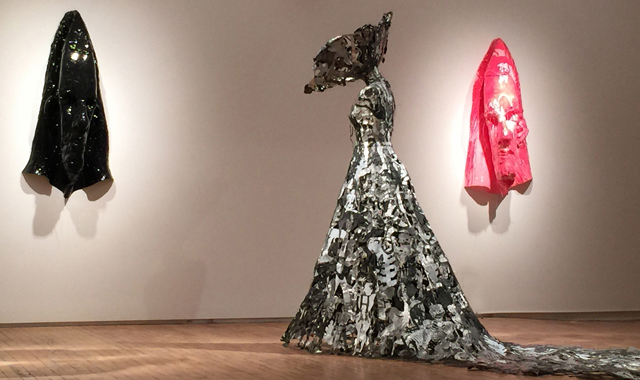by Stephen Shaheen, via blouinartinfo.com
[EXCERPT – for full article, please click here.]
On the occasion of the group exhibition “Beautiful Beast,” on view at the New York Academy of Art through March 8, artist Stephen Shaheen delved into the studio practices of each of the 16 featured sculptors.

Installation view of “Beautiful Beast” (Photo by Peter Drake)
LESLEY DILL
Stephen Shaheen: All artists, and especially sculptors, must involve collaborators (assistants, fabricators, etc.) when scale and technological exigencies exceed their individual capacities. You have made many works, including “Rush,” on a sweeping scale that required many hands to create and install. Perhaps more interestingly, you give curators freedom in determining the shape and layout of these installations; the work changes in each venue, and by the decisions of those who arrange it.
In work, such as yours, whose evocative powers hinge on transmitting an idiosyncratic and interior vision, the involvement of others creates potential contradictions. How do you feel about working with others at any point during the creative process, and do you see their semi-autonomy as a dilution or enrichment of your intent?
Lesley Dill: I don’t see how any artist can work alone. I am so happy working with people; I like working with a team, whether they’re assistants or interns. We are making something together, and I am proud of them, because they contribute so much. However, I am definitely the captain of the ship, the singer of the song, the leader of the pack, and it is my job to have a steady vision and open mind. I keep a hawk’s eye out on the work, because, though explorative, it has to be exactly right. We often work together to solve a problem, especially technically in terms of materials, and go with the best idea. This ease of small group-ness comes from my early, fortunate experience of being invited by printmakers (Landfall Press, Tamarind Press, Graphic Studio) to work with them. One relinquishes the technical aspect, but I still make sure that my “hand” is in the work. They trained me how to work with them, and I think that has really carried over.
In terms of installation, I am only an artwork’s birth mother — not it’s ultimate varying location. I trust curators! They know what they want and we discuss, send jpegs back and forth, etc. And, for my work, somebody else needs to take care of it in the world. I am such a klutz as soon as the work is out of my hands; I get nervous and risk stepping on it, ripping it, and making impulsive, bad judgments. Therefore I make calm, extremely detailed installation instructions for varying spaces. At this point there are additional collaborations: between the artist and the curator, and between the curator and the architecture. Curation is its own art.
When I have a full-throated idea, I feel as if I am teaching, bit by bit, my team to sing the same song that I am singing, so that we have this group hum, and we are making the work from that kind of atmosphere.
